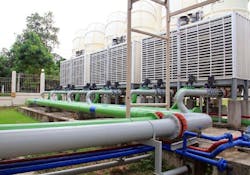In an era marked by rising energy costs and a movement toward overall sustainability, HVAC system efficiency plays a vital role in the building design process. As design engineers, building owners and mechanical contractors work to meet cost and energy efficiency expectations without sacrificing comfort for inhabitants, the technology and components of HVAC systems constantly are being revisited.
Hydronic systems and variable refrigerant flow (VRF) systems are two heating and cooling methods often compared in terms of energy consumption and system performance.
Hydronic systems provide water-based heating and cooling through pipe and other components such as pumps, drives, controls, heat exchangers and valves that deliver heated or cooled air via an air-handling unit through ductwork and air terminals. VRF systems use refrigerant as the primary heating/cooling medium and comprise a main compressor unit connected through refrigerant lines to multiple indoor cassette units that can be individually controlled.
The Evolution of Refrigerants
As building owners, designers and contractors seek to maximize building performance while minimizing environmental impact, the type of HVAC system installed is an important contributor to achieving energy efficiency targets.
During the past several decades, the HVAC industry has seen major changes in legislation restricting and banning the use of certain types of refrigerants. In late 2016, the U.S. Environmental Protection Agency (EPA) issued major changes to the Section 608 rules of the Clean Air Act, which govern the handling, use and sale of refrigerants. Most notable is the regulation banning the use of hydroflourocarbons such as R-410A in new chillers (air-cooled, water-cooled, scroll, screw and centrifugal), rooftop units and VRF systems beginning in 2024.
Under the updated rules, which go into effect Jan. 1, 2019, EPA expanded the refrigerant management program, extending the regulations to non-ozone-depleting substitutes such as hydroflourocarbons. This action lowers the allowable leak rate for comfort cooling and refrigeration appliances. It also incorporates industry best practices, such as verifying repairs and conducting annual leak inspections, for systems that have lost a small amount of their refrigerant charge.
While it is possible for leaks to develop in both hydronic and VRF systems, a leak in a VRF system is potentially lethal. Refrigerant leaks cannot be detected by sight or smell, making them difficult to locate and repair. In spaces with minimal ventilation, large concentrations of refrigerant gas in the air can put people at risk of asphyxiation.
Although hydronic systems with cooling units require refrigerant to operate, an average system uses 66% to 75% less refrigerant than a VRF system of the same size, according to the Hydronics Industry Alliance. Additionally, hydronic systems use factory-sealed refrigerant circuits, which are assembled in a controlled environment and are subject to rigorous standards and testing prior to installation. This minimizes the chances of a leak developing.
More stringent requirements for inspecting, reporting and repairing leaking equipment may push the HVAC industry to move toward technologies that are more hermetic, with fewer joints and seals, for long-term refrigerant containment. That, coupled with the phasing out of refrigerants such as R-410A and R-407c, could have a costly impact on existing VRF installations because the entire system—including piping, outdoor units and fan coils—most likely will need to be replaced.
Along with the reliance on refrigerants, there are other cost, operational performance and efficiency differences between VRF and hydronic systems.
Initial Costs
In terms of initial costs, VRF systems are often 5% to 20% more expensive than hydronic systems due to their complex refrigerant management system and controls. The need for a dedicated outdoor air system to meet ASHRAE 62 ventilation codes further adds to initial costs.
Versatility
Hydronic systems are adaptable to a variety of energy sources, from natural gas and propane to renewable energy sources such as solar thermal collectors and biomass boilers. In contrast, VRF systems are solely powered by electricity.
Additionally, hydronic systems are designed with universal components so they can be installed and serviced by a number of trained HVAC service technicians. This also makes hydronic systems more affordable to maintain, upgrade and expand. VRF components are proprietary and generally cannot be interchanged among manufacturers’ systems. This requires specialized technicians for the life of the system, from installation to adjustments to repairs, adding to lifecycle costs. The propriety nature of VRF is one of the main reasons the U.S. Department of Defense announced VRF usage is prohibited in U.S. Air Force facilities.
Building Scope
Hydronic systems are better suited to handle buildings requiring 50 to 100 tons of cooling capacity or more. They also have the capacity to pump water efficiently and effectively over long distances, such as across a sprawling campus or through high-rise office buildings.
VRF systems generally are limited to historic buildings or facilities with fewer than 10 stories. This is because the length of the piping run must be limited in order to carry refrigerants and oil through the building in accordance with manufacturer guidelines. Long lengths of piping can jeopardize performance of the unit if oil or refrigerant accumulates in the piping or migrates back to the unit. Long refrigerant piping runs also can make certain safety compliance requirements difficult to meet. It is important to note that a larger project could require multiple VRF systems, which increases costs.
Indoor Comfort
While extremely hot or cold air conditions can impact the performance of both hydronic and VRF systems, hydronic systems are less affected by temperature fluctuations. The efficiency of a VRF system is reduced as the ambient temperature goes up in the cooling mode and down in the heating mode.
At lower temperatures, hydronic systems are more reliable than VRF systems, because a VRF system in a cold climate may require a supplementary heat source, such as electric heat, which could negate the energy efficiency of the system. Without another heat source, the VRF compressor can be set to run at maximum capacity for the morning warm-up, but that takes more electricity, potentially negating any energy and cost savings.
A VRF system can provide simultaneous heating and cooling, and can recover heat from one zone to use it in another. This is effective in buildings with multiple temperature zones, such as schools or hotels. However, a VRF system does not have thermal energy storage capabilities. Water in a hydronic system can draw the heat or chill out of a room and carry that energy back to the system for storage and later use, reducing energy consumption and costs.
While VRF systems are suitable for certain buildings, hydronic systems have an advantage when it comes to shrinking a building’s carbon footprint and maximizing return on investment. Because hydronic systems are upgradable, expandable and built from universal components, they are able to change and adapt to ever-evolving building occupant needs.



